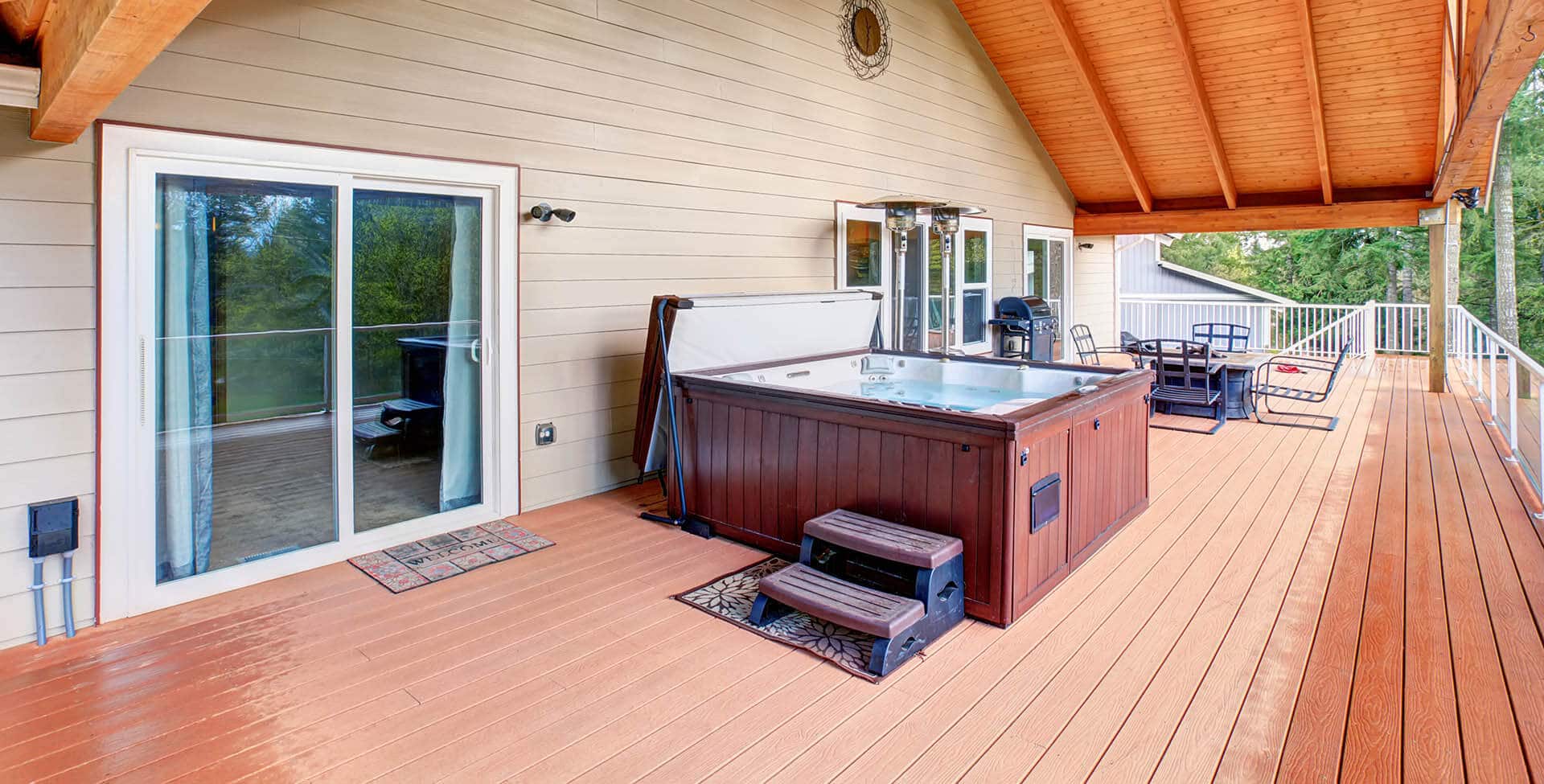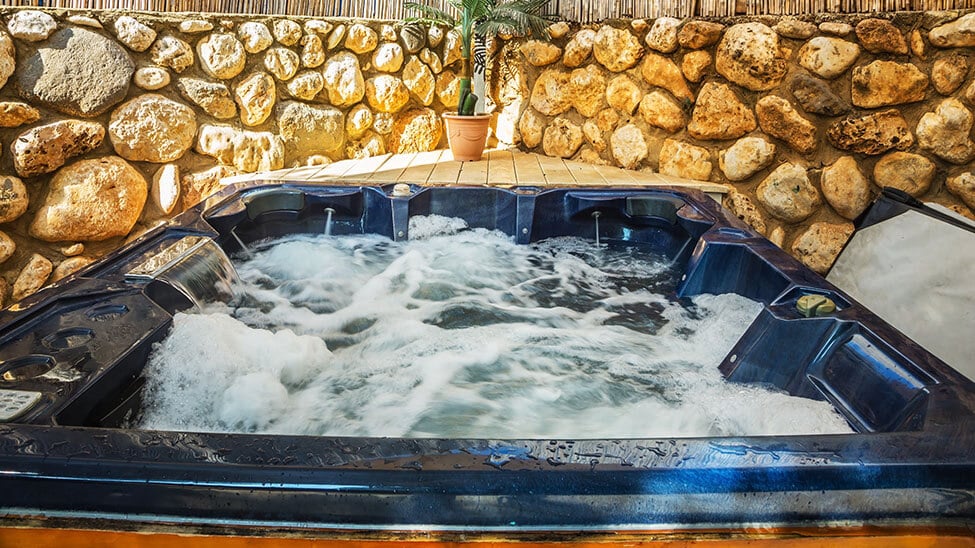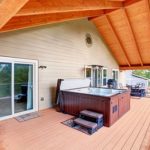
Here’s what this guide is all about
Imagine being able to get in the hot tub after work and completely switch off – a dream, right? You can easily put a little vacation like that in your backyard every evening – with an outdoor hot tub. But – to relax you need heat and how can you heat up hot tub at all? We’ll present several options and show you what works best.
What are your hot tub heating options?
Hot tub heating with solar energy
Solar collectors
An environmentally friendly method that additionally saves energy is pool heating with solar energy. The sun shines on the solar panels and heats the water that flows through them. You hardly need any additional electricity, the solar collectors only need a little energy to pump the water through. You also have an advantage in terms of price with this heating option. What you need for this option, however, is space. As a rule of thumb, the area of your solar system should be at least 80% of the area of your spa. Another disadvantage is that you won’t be able to warm up your spa in the winter, because even on a sunny day, it won’t generate enough heat to keep your spa at a comfortable temperature.
Solar tubes and solar rings
Solar tubes and rings do not require any additional energy. You can simply use the former instead of a garden hose to fill your pool and heat the water along the way. Solar rings are filled with air and float in the pool. Because of their black color, they heat up and transfer the heat to the pool water. Both options are particularly inexpensive, but even less powerful than solar collectors.
Heat up hot tub with heat pump
More expensive in comparison is the heat pump, which draws in outside air, heats it and transfers it to the pool. It does not consume additional fuel, which makes it an environmentally friendly alternative, provided that your power supply is environmentally friendly. A decisive advantage over solar collectors is that you are independent of the weather. Even in the freezing winter with gray cloudy skies, you can heat up your hot tub wonderfully. However, because it is electrically powered, a heat pump is definitely the most expensive option to use. To save energy, you should heat your spa at the warmest time of day. Then the outside air is also warmer and the heat pump does not need to heat it as much.
Heat up hot tub with pool cover
Where does your spa lose the most heat? Simple physics: at the surface of the water. Heat rises, water evaporates, and the pool cools. The logical conclusion: to keep your spa warm for as long as possible, you need an insulating cover surface. If you prevent water from evaporating, you save more than 75% of heat loss. You can do this with pool covers, which are best installed so that heat can’t escape through any cracks. Advantages of pool covers are that they do not consume energy and they also protect from leaves, insects or other contaminants in the pool.
Cover tarps
For stand-up hot tubs, thermal insulation works best with a pool cover tarp. These are often included, or you can buy them cheaply if you choose the appropriate dimensions. Simple tarps with a thermal layer are especially handy and can be quickly installed and removed. However, air-filled tarpaulins provide better insulation. However, the air filling makes them more bulky at the same time.
Automatic pool cover
This type of pool cover works similarly to an electrically operated blind. It consists of individual plastic elements that are joined together, and rolled up on a roller when not in use. When you’re done soaking in the hot tub, you simply push a button and the cover unrolls over the pool. This cover works even better than a tarp, but it’s only suitable for permanently installed pools. There’s also the risk of the material collapsing if the snow load is too heavy in the winter.
Heat up hot tub with gas
If you heat with gas, an inexpensive alternative can be to connect your hot tub to the house connection. In this case, the water in a hose is heated by the gas. However, you need electricity for a heat pump that pumps the pool water through the hose. Especially for a larger hot tub, this method is still cheaper than heating with electricity only via a heat pump. You can see what that looks like when you heat your hot tub with gas in the video linked below.
Heating a hot tub with wood
Want a campfire atmosphere? With a suitable wood stove, you can heat the water for your hot tub over the fire. Of course, this requires that the stove has a water flow. Such a stove is relatively expensive and the pump for it is also electrically operated. You also need to add wood regularly, fire heats less evenly and takes longer to bring the water up to temperature. So heating the hot tub with fire is not the most practical or cost-effective option, but it definitely creates an adventurous and romantic atmosphere.
Tips – this is how hot tub heating works
Combine the options
As you’ve seen, all the variants have advantages and disadvantages, so why not pick the best? For example, you can use a solar hose, depending on the weather, to heat up the water before it even gets into the hot tub. A tarp to retain heat is also recommended with all options.
Reduce energy consumption during heating
Not only can you save energy by finding the best heating method for your pool, but you can also reduce energy consumption when it’s highest: during heat-up. So while the spa is heating up, be sure to keep the cover spread out so that the heat you just created doesn’t dissipate right away. If you plan to use your spa frequently during the winter months, it is advisable not to let the temperature drop. You will then use less energy to keep the water at temperature than it would cost you if you had to reheat it each time. It also saves a long wait, because in most cases even powerful heating modules heat the water by a maximum of 3 degrees an hour. So if the water temperature is close to freezing, you can calculate how long it will take to go swimming….
Take care of cold protection
Outdoor hot tubs lose heat primarily through the wind. So if you manage to shield your pool well, it’s not only more comfortable for you while you’re relaxing in the water. You also save a lot of energy. We recommend wind shields or a garden house where you can store your hot tub.







